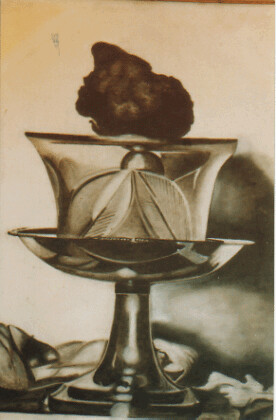Bodhisattva Thích Quảng Đức's remains were coffined and displayed for a few days at Xa Loi Temple, then it was transported to An Duong Dia (Phu Lam), a cremation site on the outskirts of Saigon. After many hours (from 8am to 2pm), the coffin with his remains turned into ashes, but one miracle happened: His heart was still red and soft. All the Buddhist dignitaries present at the site decided to re-cremate the heart. However long it had been put in the fire, to everybody's consternation, the heart still remained as solid as a rock. It had become a relic.
Buddhists knelt down. Some wept; some chanted Buddhas' names, for they knew that what the Bodhisattva had said before his demise had come true.
The story about the Bodhisattva Thích Quảng Đức's imperishable heart had been distorted and manipulated by Diem government, and there were many rumors and versions. However, because so many Buddhists, non-Buddhists, and national and international correspondents had witnessed the cremation from the beginning to the end, nobody could deny the truth.
When asked by one international correspondent about the imperishable heart of the Bodhisattva, Thich Duc Nghiep replied:
It was imperishable, because Bodhisattva Thích Quảng Đức had made such a great vow to sacrifice for the Dhamma and national peace that his mind and energy were focused on the heart, and made it imperishable.
After the cremation, according to Thich Duc Nghiep, the heart was secretly well protected in Mr. Chanh Tri Mai Tho Truyen's safe. On August 20, 1963, police came to Xa Loi temple and searched for the heart, but they could not find it. Later, it was transported to Vietnam Quoc Tu (Vietnam National Temple)under the protection of Bhikku Thich Tu Nhon. It was enshrined within a brass stupa of half a meter in height, which nobody could see what was inside. The stupa was sealed with the signature of Most Venerable Thich Tinh Khiet, Vietnam Buddhism Patriarch at that time. Now at the age of 85, Bhikkhu Thich Tu Nhon recalled that the Patriarch had ordered him to leave Sadec to come to Saigon to assume the special task of protecting the sacred heart. At first it was kept in the Abbot's safe in Vietnam Quoc Tu, a huge temple surrounded by trees and trees. Because the Abbot's room was simple, and easily frequented by police or secret agents, Thich Tu Nhon had enshrined the relic in the stupa, and deposited it in a safe in the basement of the France Bank in Saigon. He was the only one who had the key to the safe. The other key was kept in the headquarters of the bank in France. Even the Saigon branch of the France Bank could not open it.
Before 1975, during the Vietnam war, the relic was kept there. After 1975, it was under the protection of the Vietnam government. In 1991, it was transferred to the State Bank in Ho Chi Minh City with the presence of such Buddhists dignitaries as Thich Tu Nhon, Thich Giac Toan, and Thich Thien Hao. The stupa's seal with the signature of the Patriarch remained intact. Nobody could look inside the stupa, but they believed the relic was there.
Thich Tu Nhon said:
I hope that, after the construction of Bodhisattva Thích Quảng Đức's Monument is completed, his heart relic would be enshrined there, so that everybody may be able to pay homage to him again. It was what he left to the Vietnamese people as a reminder that despite all the changes of regimes and all the difficulties, the Dhamma, peace and justice will be protected and restored for the multitude.
On June 2, 2010 at the intersection of Cach Mang Thang Tam Street and Nguyen Dinh Chieu Street (which used to be Phan Dinh Phung Street and Le van Duyet Street in 1963), the Monument of Bodhisattva Thích Quảng Đức was re-established in a solemn inauguration ceremony by the Vietam Buddhist Sangha and the Municipal Cultural Department of Ho Chi Minh City. A brass statue of four meters in height and 4.5 meters in diameter was installed on the shrine, vividly depicting his self-immolation in 1963.
The Meaning of Bodhisattva Thích Quảng Đức's Self-Immolation
The supernatural characteristics of Bodhisattva Thích Quảng Đức's self-immolation, and his wisdom, compassion, and bravery as manifested in his sitting calmly in lotus position in the flames, have become a bright torch that helps to destroy ignorance and illusion from all evil forces. His self sacrifice torch had lit the path for other Vietnamese Buddhists in their struggle for religious freedom and equality. After him, there were many monks, nuns, and lay Buddhists who continued to protest Diem administration, and who had sacrificed their lives either during the struggles, or under torture in prisons, or by self-immolation. They were Bhikkus Nguyen Huong, Thanh Tue, Quang Huong, Thien My, Tieu Dieu, Bhikkuni Dieu Quang, and some lay people such as Quach thi Trang, Nhat Linh, Mai Tuyet Anh, and many others who offered their lives for the protection of the Dhamma and Vietnam Buddhism.
Bodhisattva Thích Quảng Đức's robe could be compared to the cremation scaffolds which finally burned and toppled Diem government on November 1, 1963, putting an end to a dictatorial and nepotistic regime in Vietnam history. His imperishable heart has become the symbol of the Vietnamese Buddhists' struggle for peace, freedom, equality against any oppression, unjustice, and dictatorial regime.
Bodhisattva Thích Quảng Đức's self-immolation also proves that Vietnam Buddhism has a long tradition of engagement in all national activities, and that since the beginning, it has undergone many national vicissitudes. As the Tathagata's sons and daughters, the Buddhists rarely fear any difficulty or adversary in life, and in the struggle for peace and freedom against any oppression.
Sources:
http://en.wikipedia.org/wiki/Thich_Quang_Duc
Quoc Viet. The Immortal Heart. http://tuoitre.vn. A three-part document. Posted from May 31, 2010 to June 3, 2010.
http://www.go.vn/news/630-5185/anh-truyen/anh-thoi-su-vi-dai-nhat-moi-thoi-dai.htm

